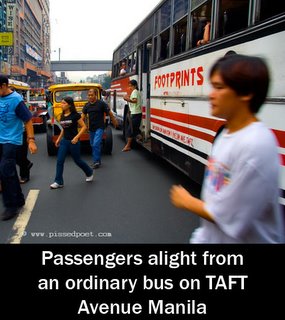
Ordinary buses are buses pretending to be jeepneys. The glass in the windows has either departed for a life of luxury in more hospitable surroundings or is locked in place from years of inaction. Although the seating is across the vehicle rather than running down the sides, it is of the bench variety and often unpadded. As most buses ply the major thoroughfares, the exhaust fumes of the other uses is an included extra.
The aircon bus will have its windows in place plus padded seating, 3 on one side of the isle, 2 on the other. “Fresh” air will be pumped at you from adjustable, little vents in the overhead luggage rack and sometimes they are actually adjustable. On most aircon buses there will be curtains on the windows which are very handy at high noon. If you want to watch the passing parade, push them to one side and peer through a couple of week’s accumulated dirt. A lot of aircon buses have video on board, a selling point proudly displayed on the wind screen.
Suburban buses don’t run to any time table they just ply back and forth along their route. Buses to the provinces do depart at certain times from their terminus and it is wise to check the times of your chosen carrier of which there are many.

All buses have a conductor who collects the fares, which are determined on the distance you are traveling. You will be issued with a paper ticket which either looks like a chook raffle stub or one printed with an intricate series of little boxes with holes punched in certain ones. Reading the tickets is a science in itself.
The conductor also touts loudly for potential customers at designated stops or at pedestrians who are looking in his direction. A customer is a customer, one getting off is making room for another to get on. Consequently, a bus will stop to set down or pick up a passenger anywhere along its route.
To hail a bus, as with jeepneys, attract the attention of either the driver or the conductor of your chosen carrier. This can be determined by the destination notice hanging on the wind screen, from the shouts of the conductor or the sign in his hand. Along the way, street sellers will board to hawk their wares of snacks, drinks and trinkets and get off the next time the bus stops.
On provincial buses it isn’t advisable to sit too close to the front unless you’re a seasoned traveler. On a trip back from the provence, Nueva Ecija, I noticed a fellow Kano seated right behind the driver. When we stopped for a comfort rest half way through the journey his knuckles were white. He swore we had spent at least a third of the time on the wrong side of the road.
Even if you're not in the city, fear not, provincial buses like their suburban counterparts will pick up passengers along the way. When all the seats are full, little stools appear so customers can sit in the isle.
There is always room for one more.

I have to admit that catching buses in the philippines is a chore by itself not only the waiting but the journey itself.I had the privilage with my asawa to catch a bus to baguio from manila and also to bayambong which are both 7 hour trips the scenery during the trip was beautiful but i have to agree that the middle is the better part of the bus if you like you to stay sane during the trip as for catching buses in manila i think i will stick too jeepneys or an fx a little quicker for me
ReplyDelete